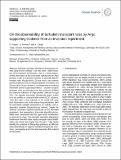On the observability of turbulent transport rates by Argo: supporting evidence from an inversion experiment
Author(s)
Ferreira, D.; Forget, Gael; Liang, Xinfeng
DownloadForget-2015-On the observability.pdf (2.238Mb)
OPEN_ACCESS_POLICY
Open Access Policy
Creative Commons Attribution-Noncommercial-Share Alike
Terms of use
Metadata
Show full item recordAbstract
Although estimation of turbulent transport parameters using inverse methods is not new, there is little evaluation of the method in the literature. Here, it is shown that extended observation of the broad-scale hydrography by Argo provides a path to improved estimates of regional turbulent transport rates. Results from a 20-year ocean state estimate produced with the ECCO v4 (Estimating the Circulation and Climate of the Ocean, version 4) non-linear inverse modeling framework provide supporting evidence. Turbulent transport parameter maps are estimated under the constraints of fitting the extensive collection of Argo profiles collected through 2011. The adjusted parameters dramatically reduce misfits to in situ profiles as compared with earlier ECCO solutions. They also yield a clear reduction in the model drift away from observations over multi-century-long simulations, both for assimilated variables (temperature and salinity) and independent variables (biogeochemical tracers). Despite the minimal constraints imposed specifically on the estimated parameters, their geography is physically plausible and exhibits close connections with the upper-ocean stratification as observed by Argo. The estimated parameter adjustments furthermore have first-order impacts on upper-ocean stratification and mixed layer depths over 20 years. These results identify the constraint of fitting Argo profiles as an effective observational basis for regional turbulent transport rate inversions. Uncertainties and further improvements of the method are discussed.
Date issued
2015-10Department
Massachusetts Institute of Technology. Department of Earth, Atmospheric, and Planetary SciencesJournal
Ocean Science
Publisher
Copernicus GmbH
Citation
Forget, G., D. Ferreira, and X. Liang. “On the Observability of Turbulent Transport Rates by Argo: Supporting Evidence from an Inversion Experiment.” Ocean Science 11, no. 5 (2015): 839–853.
Version: Final published version
ISSN
1812-0792